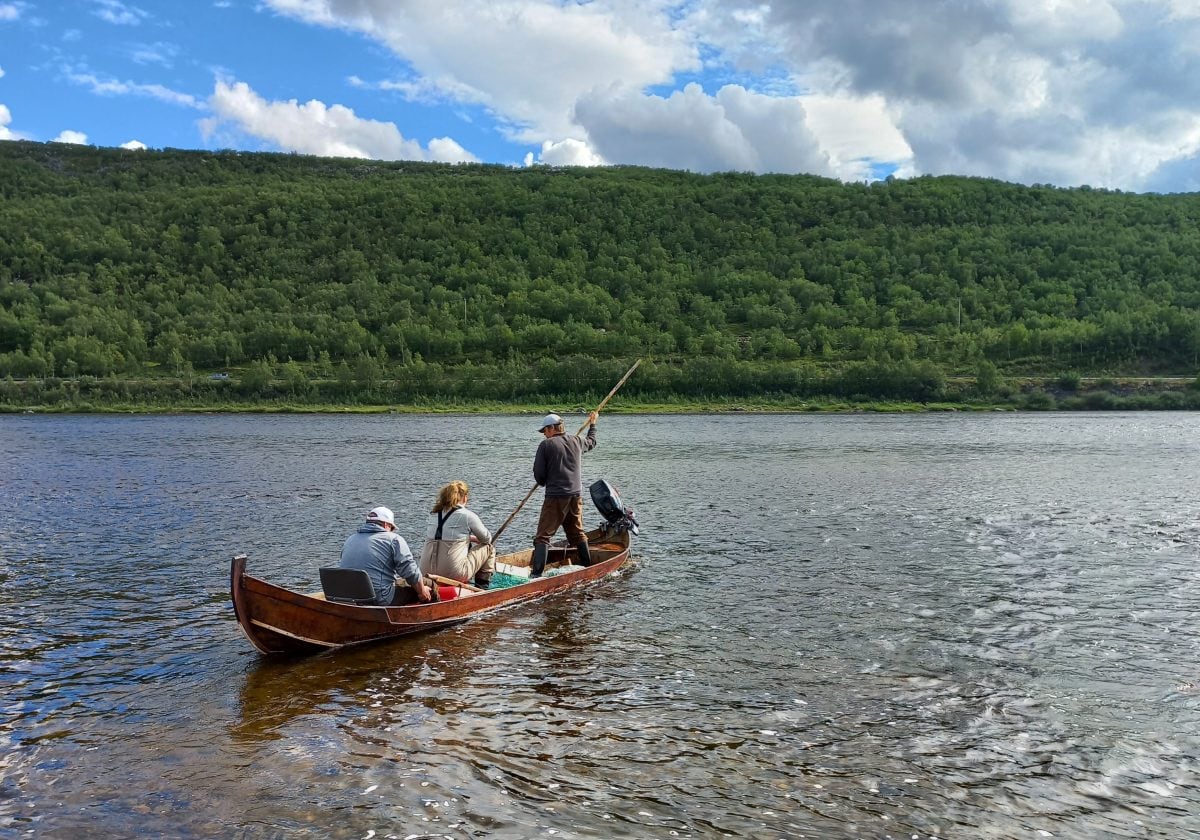The Barents IAS project’s research on the pink salmon has been in full swing during summer 2023. The project has been testing the suitability of different drift nets and seines for catching pink salmon on the river Tana. The fishing is largely carried out by local people. Without their expertise it would be much more difficult to develop and test fishing methods. Cooperation between Luke’s researchers and local people is therefore a prerequisite for the success of the project.
Pink salmon spawn in very shallow water, which poses challenges for the methods being developed. In a shallow rocky river fishing nets should not stick to the bottom, and familiarity with the entire riverbed is important to ensure a successful catch. In addition, the fishing boat should not scrape the rocks on the riverbed; few boat models are able to meet this challenge.

Traditional Tana riverboats are used for drift netting
Tana riverboats are used for drift netting. The Tana riverboat has been developed over time to suit the specific conditions of the river and can navigate in surprisingly shallow water without any problems. According to a local saying, a Tana riverboat can sail even on a wet road.
Drift netting itself does not take long. One end of the net attached to a piece of wood or other floating object is thrown into the water and the other end is held by hand on the boat. The net is allowed to drift transversely in the river at the same pace as the boat. The splashing on the water surface starts almost immediately as the pink salmon hit the net and are caught. After a few minutes, the net is pulled back into the boat with dozens of pink salmon. Removing the pink salmon from the net, on the other hand, is slow and can easily take half an hour, if not more. The males’ teeth, in particular, are awe-inspiring and get badly tangled in the net.

The river must be familiar in order to seine
Seining on the river Tana is a more massive undertaking than drift netting. It requires a group holding a seine on a boat and another group standing in the water downstream to hold another net that will eventually meet the upstream seine. Sometimes there may also be people with wooden poles standing by the downstream net to make noise and scare the pink salmon away from the gap between the two nets where the fish could escape. The river Tana is so shallow in many places that a long row of people can stand in the middle of the river holding a net.
Local knowledge of the river is often invaluable. For example, when planning the seine, locals were able to tell that there was a particular stone downriver that could cause trouble. The stone was rolled out of the way so that the seine would not get caught on it and open an escape route for the pink salmon.
Of course, there may be many ways to seine pink salmon and the above description is only from the time I was able to observe the seining myself. On that occasion, the catch was around 100-200 individuals per seining session. More detailed information on the different fishing methods and techniques will be collected in the autumn when the busiest field season is over. Information will be made available on the project website.

Fatal rotting already starts during spawning
I visited Utsjoki in the first week of August. In one week alone, there was a clear change in the pink salmon. At the beginning of the week, the fish were already in their spawning stage, i.e., they had turned dark and the males had developed humpbacks and hooked jaws but the fish were in good condition. Towards the end of the week, many of the pink salmon had started to fall apart and rotting preceding the death of the individuals could be clearly observed. Also, towards the end of the week individual dead fish started turning up along the riverbank. After mid-August the banks of the river Tana will really start to fill up with carcasses of pink salmon and the Tana will smell, to borrow a local expression, like a “sewer”. The aim is that by the time of the mass run of pink salmon in the summer of 2025, the lessons of this summer can be applied on a much larger scale.
See how much pink salmon is cought in the drift net!
Project coordinator Heidi Blom visited Utsjoki to see the project’s pink salmon activities in the first week of August. The Barents invasive alien species (IAS) project will develop methods for catching pink salmon and disseminate knowledge and good practice on invasive alien species. The project is funded by the IBA funding mechanism, the Baltic Sea, Barents Sea and Arctic regions grant, which contributes to the practical implementation of related Finnish policy objectives.
Text and photos: Heidi Blom
